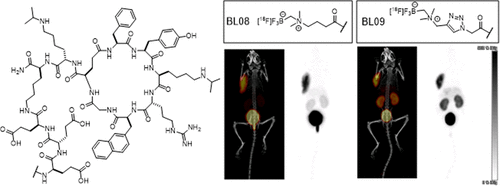当前位置:
X-MOL 学术
›
Mol. Pharmaceutics
›
论文详情
Our official English website, www.x-mol.net, welcomes your
feedback! (Note: you will need to create a separate account there.)
High-Contrast CXCR4-Targeted 18F-PET Imaging Using a Potent and Selective Antagonist
Molecular Pharmaceutics ( IF 4.5 ) Pub Date : 2020-11-30 , DOI: 10.1021/acs.molpharmaceut.0c00785 Daniel Kwon 1 , Jerome Lozada 2 , Zhengxing Zhang 1 , Jutta Zeisler 1 , Richel Poon 2 , Chengcheng Zhang 1 , Áron Roxin 1 , Kuo-Shyan Lin 1, 3 , David Perrin 2 , Francois Benard 1, 3
Molecular Pharmaceutics ( IF 4.5 ) Pub Date : 2020-11-30 , DOI: 10.1021/acs.molpharmaceut.0c00785 Daniel Kwon 1 , Jerome Lozada 2 , Zhengxing Zhang 1 , Jutta Zeisler 1 , Richel Poon 2 , Chengcheng Zhang 1 , Áron Roxin 1 , Kuo-Shyan Lin 1, 3 , David Perrin 2 , Francois Benard 1, 3
Affiliation

|
C-X-C chemokine receptor 4 (CXCR4) is highly expressed in cancers, contributing to proliferation, metastasis, and a poor prognosis. The noninvasive imaging of CXCR4 can enable the detection and characterization of aggressive cancers with poor outcomes. Currently, no 18F-labeled CXCR4 positron emission tomography (PET) radiotracer has demonstrated imaging contrast comparable to [68Ga]Ga-Pentixafor, a CXCR4-targeting radioligand. We, therefore, aimed to develop a high-contrast CXCR4-targeting radiotracer by incorporating a hydrophilic linker and trifluoroborate radioprosthesis to LY2510924, a known CXCR4 antagonist. A carboxy-ammoniomethyl-trifluoroborate (PepBF3) moiety was conjugated to the LY2510924-derived peptide possessing a triglutamate linker via amide bond formation to obtain BL08, whereas an alkyne ammoniomethyl-trifluoroborate (AMBF3) moiety was conjugated using the copper-catalyzed [3+2] cycloaddition click reaction to obtain BL09. BL08 and BL09 were radiolabeled with [18F]fluoride ion using 18F–19F isotope exchange. Pentixafor was radiolabeled with [68Ga]GaCl3. Side-by-side PET imaging and biodistribution studies were performed on immunocompromised mice bearing Daudi Burkitt lymphoma xenografts. The biodistribution of [18F]BL08 and [18F]BL09 showed tumor uptake at 2 h postinjection (p.i.) (5.67 ± 1.25%ID/g and 5.83 ± 0.92%ID/g, respectively), which were concordant with the results of PET imaging. [18F]BL08 had low background activity, providing tumor-to-blood, -muscle, and -liver ratios of 72 ± 20, 339 ± 81, and 14 ± 3 (2 h p.i.), respectively. [18F]BL09 behaved similarly, with ratios of 64 ± 20, 239 ± 72, and 17 ± 3 (2 h p.i.), respectively. This resulted in high-contrast visualization of tumors on PET imaging for both radiotracers. [18F]BL08 exhibited lower kidney uptake (2.2 ± 0.5%ID/g) compared to [18F]BL09 (7.6 ± 1.0%ID/g) at 2 h p.i. [18F]BL08 and [18F]BL09 demonstrated higher tumor-to-blood, -muscle, and -liver ratios compared to [68Ga]Ga-Pentixafor (18.9 ± 2.7, 95.4 ± 36.7, and 5.9 ± 0.7 at 2 h p.i., respectively). In conclusion, [18F]BL08 and [18F]BL09 enable high-contrast visualization of CXCR4 expression in Daudi xenografts. Based on high tumor-to-organ ratios, [18F]BL08 may prove a valuable new tool for CXCR4-targeted PET imaging with potential for translation. The use of a PepBF3 moiety is a new approach for the orthogonal conjugation of organotrifluoroborates for 18F-labeling of peptides.
中文翻译:

使用强效选择性拮抗剂的高对比度 CXCR4 靶向 18F-PET 成像
CXC 趋化因子受体 4 (CXCR4) 在癌症中高度表达,有助于增殖、转移和不良预后。CXCR4 的无创成像可以检测和表征预后不良的侵袭性癌症。目前,没有18 F 标记的 CXCR4 正电子发射断层扫描 (PET) 放射性示踪剂已证明成像对比度可与 [ 68 Ga] Ga-Pentixafor(一种 CXCR4 靶向放射性配体)相媲美。因此,我们旨在通过将亲水性接头和三氟硼酸盐放射性假体与已知的 CXCR4 拮抗剂 LY2510924 结合来开发高对比度 CXCR4 靶向放射性示踪剂。羧基氨甲基三氟硼酸盐 (PepBF 3) 部分通过酰胺键形成与具有三谷氨酸接头的 LY2510924 衍生肽缀合以获得 BL08,而炔烃氨甲基三氟硼酸盐 (AMBF 3 ) 部分使用铜催化的 [3+2] 环加成点击反应缀合以获得BL09。BL08 和BL09 使用[ 18 F] 氟离子使用18 F– 19 F 同位素交换进行放射性标记。Pentixafor 用[ 68 Ga]GaCl 3进行放射性标记。对携带道迪伯基特淋巴瘤异种移植物的免疫功能低下的小鼠进行并排 PET 成像和生物分布研究。[ 18 F]BL08和[ 18的生物分布F]BL09 在注射后 2 小时 (pi) 显示肿瘤吸收(分别为 5.67 ± 1.25% ID/g 和 5.83 ± 0.92% ID/g),这与 PET 成像结果一致。[ 18 F]BL08 具有低背景活性,提供的肿瘤与血液、肌肉和肝脏的比率分别为 72 ± 20、339 ± 81 和 14 ± 3(注射后 2 小时)。[ 18 F]BL09 表现相似,比率分别为 64 ± 20、239 ± 72 和 17 ± 3 (2 h pi)。这导致两种放射性示踪剂在 PET 成像上的肿瘤高对比度可视化。[ 18 F]BL08 与[ 18 F]BL09 (7.6 ± 1.0%ID/g) 相比,在注射后 2 小时 [ 18 F]BL08 和 [ 18与[ 68 Ga] Ga-Pentixafor相比,F]BL09 表现出更高的肿瘤与血液、肌肉和肝脏的比率(注射后 2 小时分别为 18.9 ± 2.7、95.4 ± 36.7 和 5.9 ± 0.7)。总之,[ 18 F]BL08 和[ 18 F]BL09 能够实现 Daudi 异种移植物中 CXCR4 表达的高对比度可视化。基于高肿瘤器官比,[ 18 F]BL08 可能证明是一种有价值的新工具,用于 CXCR4 靶向 PET 成像,具有转化潜力。使用 PepBF 3部分是有机三氟硼酸盐正交缀合用于肽的18 F 标记的一种新方法。
更新日期:2021-01-04
中文翻译:

使用强效选择性拮抗剂的高对比度 CXCR4 靶向 18F-PET 成像
CXC 趋化因子受体 4 (CXCR4) 在癌症中高度表达,有助于增殖、转移和不良预后。CXCR4 的无创成像可以检测和表征预后不良的侵袭性癌症。目前,没有18 F 标记的 CXCR4 正电子发射断层扫描 (PET) 放射性示踪剂已证明成像对比度可与 [ 68 Ga] Ga-Pentixafor(一种 CXCR4 靶向放射性配体)相媲美。因此,我们旨在通过将亲水性接头和三氟硼酸盐放射性假体与已知的 CXCR4 拮抗剂 LY2510924 结合来开发高对比度 CXCR4 靶向放射性示踪剂。羧基氨甲基三氟硼酸盐 (PepBF 3) 部分通过酰胺键形成与具有三谷氨酸接头的 LY2510924 衍生肽缀合以获得 BL08,而炔烃氨甲基三氟硼酸盐 (AMBF 3 ) 部分使用铜催化的 [3+2] 环加成点击反应缀合以获得BL09。BL08 和BL09 使用[ 18 F] 氟离子使用18 F– 19 F 同位素交换进行放射性标记。Pentixafor 用[ 68 Ga]GaCl 3进行放射性标记。对携带道迪伯基特淋巴瘤异种移植物的免疫功能低下的小鼠进行并排 PET 成像和生物分布研究。[ 18 F]BL08和[ 18的生物分布F]BL09 在注射后 2 小时 (pi) 显示肿瘤吸收(分别为 5.67 ± 1.25% ID/g 和 5.83 ± 0.92% ID/g),这与 PET 成像结果一致。[ 18 F]BL08 具有低背景活性,提供的肿瘤与血液、肌肉和肝脏的比率分别为 72 ± 20、339 ± 81 和 14 ± 3(注射后 2 小时)。[ 18 F]BL09 表现相似,比率分别为 64 ± 20、239 ± 72 和 17 ± 3 (2 h pi)。这导致两种放射性示踪剂在 PET 成像上的肿瘤高对比度可视化。[ 18 F]BL08 与[ 18 F]BL09 (7.6 ± 1.0%ID/g) 相比,在注射后 2 小时 [ 18 F]BL08 和 [ 18与[ 68 Ga] Ga-Pentixafor相比,F]BL09 表现出更高的肿瘤与血液、肌肉和肝脏的比率(注射后 2 小时分别为 18.9 ± 2.7、95.4 ± 36.7 和 5.9 ± 0.7)。总之,[ 18 F]BL08 和[ 18 F]BL09 能够实现 Daudi 异种移植物中 CXCR4 表达的高对比度可视化。基于高肿瘤器官比,[ 18 F]BL08 可能证明是一种有价值的新工具,用于 CXCR4 靶向 PET 成像,具有转化潜力。使用 PepBF 3部分是有机三氟硼酸盐正交缀合用于肽的18 F 标记的一种新方法。











































 京公网安备 11010802027423号
京公网安备 11010802027423号